Taulman T-glase 3D printing filament selected as the filament of choice for Food Rising grow system objects
 Wednesday, March 11, 2015
Wednesday, March 11, 2015
by Mike Adams, the Health Ranger
Tags: Taulman t-glase, 3D printing filament, how to print
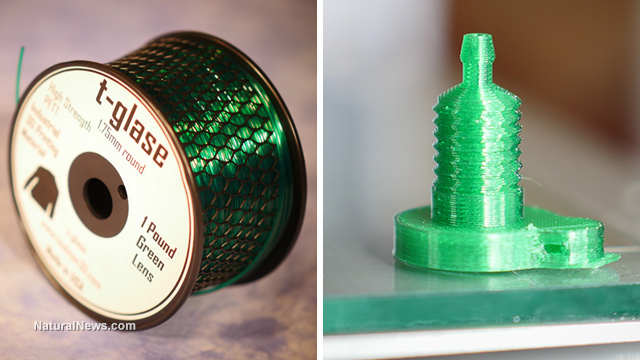
(NaturalNews) After months of testing almost every 3D printing filament available today, I am naming Taulman T-glase as the "filament of choice" for printing the food system objects released at FoodRising.org.
Food Rising is the non-profit website where you can learn how to make your own non-electric food grow systems that produce strawberries, tomatoes, lettuce and medicinal herbs without using electricity. A key part of the system -- the automatic float valve -- can be 3D printed by downloading the free object files posted on www.FoodRising.org
Additional inventions are coming this year, including my next invention which is an object that can remove arsenic from contaminated well water. This object will also be freely posted and downloadable. It can be printed on any 3D printer.
Taulman t-glase is the perfect material for printing strong, functional, water-tight objects
T-glase (pronouced "tee-glass") is a PET-based filament created by Tom Taulman of the Taulman company near St. Louis, Missouri. Taulman is best known for its "bridge nylon" filament which produces structurally rigid objects for prototyping and real-world use.After testing PLA, ABS, nylon, Colorfabb XT, various PET filaments and many others, I found that Taulman t-glase was the ideal filament for Food Rising projects.
Here's a pic of me holding some of the Float Valve Adapters we're mass printing with Taulman t-glase:
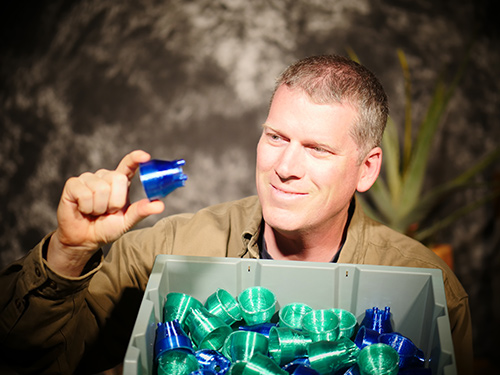
Why, exactly, is it the ideal filament? Let me count the ways:
• T-glase prints objects that are water tight. Most other filaments do not. ABS, for example, leaks through the layers.
• T-glase is made of a material that's approved by the FDA as a food contact surface.
• T-glase is BPA-free.
• T-glase can be easily recycled and transformed into new filament to print new objects.
• T-glase has outstanding fracture resistance. Finished parts are extremely durable and very difficult to break if printed correctly (see print instructions below).
• T-glase suffers from virtually no shrinkage during printing. It can even be printed on non-heated print beds.
• T-glase remains flexible at the same time that it is also rigid. It can be deformed or bent with force and return to its original shape, without fracturing or breaking.
• T-glase is made in America and was created by an American company. Call me a patriot, but I like to support American companies wherever possible.
T-glase is available now at SupplySource.com, in both 1.75 and 2.85mm diameters, in colors that include red, green, blue and black.
Render of the Float Valve Receiver available at FoodRising.org:
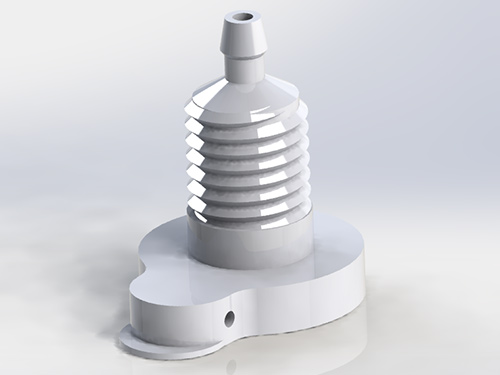
Print farm screen shot, producing nine of these receivers on the LulzBot Mini:
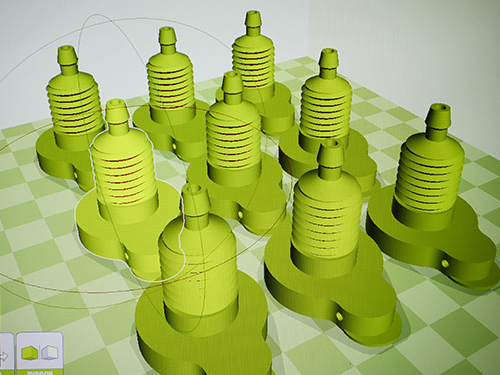
Printing them on the LulzBot Mini. Notice the PEI print bed and NO GLUE!
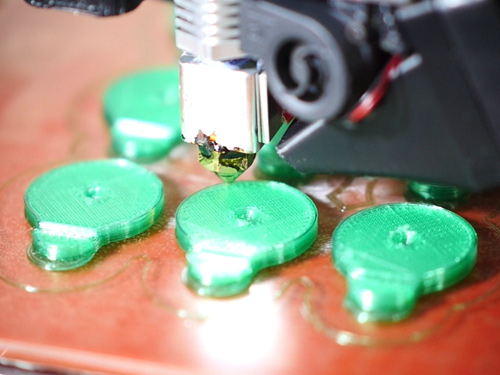
Finished part. Notice the precision threads:
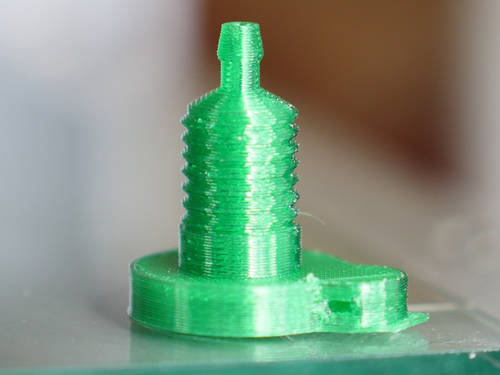
How to successfully print with T-glase
T-glase is remarkably easy to print if you adhere to the guidelines. Bed adhesion is best achieved by applying this LulzBot PEI print surface to your existing print bed. After you achieve this, you do NOT need to use any glue, ABS juice or any other method at all.With PEI sheets, you can be 100% free of bed adhesives!
Printing some Float Valve Adapters on the Ultimaker 2 using t-glase:
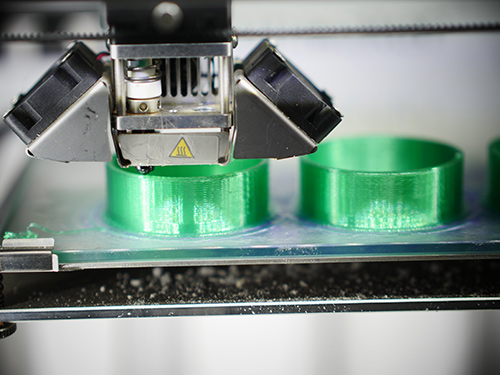
Next, you need to increase the size of your print nozzle to a minimum of 0.5mm. Printers that come with nozzles of 0.4mm will need to be drilled out to 0.5mm or larger. (I run some printers at 0.6mm and others at 0.7mm.) This can be accomplished using these micro drills and some careful finger-twisting / hand-drilling. (Do not use a Dremel or you will break off the drill bit inside the nozzle. Fun!)
For many printers, you can simply buy nozzles of 0.5mm or better. The new LulzBot Mini ships standard with a 0.5mm nozzle that works great with T-glase!
Next, you'll want to set a print temperature between 240C and 250C. This is much hotter than what people have previously reported for T-glase, but I have this information straight from Tom Taulman himself. He told me on the phone, "You want to set your temperature as high as you can go without producing air bubbles in the print." In other words, keep raising your temperature until you get air bubble effects, and then back off about 5 degrees. That's the temperature you want. For my printers, it's almost always at 250C.
PRINT SPEED: T-glase must be printed more slowly than ABS and other filaments. For the objects I'm printing, which have negative space cylinders and inverted cones that are susceptible to cross-stringing, the max speed I use is around 40mm/s. You can push it to 45 in some circumstances, but I would never exceed 45 when printing t-glase.
For the first layer of t-glase, slow it way down to around 16mm/s. (This is set in your slicer.)
SLICER SETTINGS: I like Cura as the slicer. It just works. The most important setting in your slicer is the layer height. Most people go totally bonkers on this and think that if they set a smaller layer height, they get a better objects. This is flatly false. Please understand that smaller layer heights make more fragile objects. Larger layer heights make stronger objects due to the laws of chemistry and physics (more material is bonding with each layer). So when printing functional objects using t-glase, you want a layer height of 0.25mm or more.
Larger layer heights also print objects far more quickly. So if you want strong objects faster, use larger layer heights.
I usually run most of my Food Rising objects at 0.35mm layer heights. Objects that contain threads, such as the Float Valve Receiver, will be run at 0.30mm layer height. Certain parts for my upcoming inventions (things that remove arsenic from well water) need to be printed at 0.25mm layer height. But overall, you want to run t-glase at around 0.3mm layer height.
SUMMARY:
Print temperature: 250C
Bed temperature: 0C - 70C
Nozzle size: 0.5mm - 0.7mm (0.4mm nozzle is too small to print t-glase)
Layer height: 0.35mm (do not go below 0.25mm)
Print speed: 20 - 40 mm/s (use 16mm/s for first layer)
T-glase is available now at SupplySource.com in various colors and filament diameters.
Taulman t-glase at FETCH.news
Get independent news alerts on natural cures, food lab tests, cannabis medicine, science, robotics, drones, privacy and more.
 About the author:Mike Adams (aka the "Health Ranger") is a best selling author (#1 best selling science book on Amazon.com) and a globally recognized scientific researcher in clean foods. He serves as the founding editor of NaturalNews.com and the lab science director of an internationally accredited (ISO 17025) analytical laboratory known as CWC Labs. There, he was awarded a Certificate of Excellence for achieving extremely high accuracy in the analysis of toxic elements in unknown water samples using ICP-MS instrumentation. Adams is also highly proficient in running liquid chromatography, ion chromatography and mass spectrometry time-of-flight analytical instrumentation.
About the author:Mike Adams (aka the "Health Ranger") is a best selling author (#1 best selling science book on Amazon.com) and a globally recognized scientific researcher in clean foods. He serves as the founding editor of NaturalNews.com and the lab science director of an internationally accredited (ISO 17025) analytical laboratory known as CWC Labs. There, he was awarded a Certificate of Excellence for achieving extremely high accuracy in the analysis of toxic elements in unknown water samples using ICP-MS instrumentation. Adams is also highly proficient in running liquid chromatography, ion chromatography and mass spectrometry time-of-flight analytical instrumentation.
Adams is a person of color whose ancestors include Africans and Native American Indians. He's also of Native American heritage, which he credits as inspiring his "Health Ranger" passion for protecting life and nature against the destruction caused by chemicals, heavy metals and other forms of pollution.
Adams is the founder and publisher of the open source science journal Natural Science Journal, the author of numerous peer-reviewed science papers published by the journal, and the author of the world's first book that published ICP-MS heavy metals analysis results for foods, dietary supplements, pet food, spices and fast food. The book is entitled Food Forensics and is published by BenBella Books.
In his laboratory research, Adams has made numerous food safety breakthroughs such as revealing rice protein products imported from Asia to be contaminated with toxic heavy metals like lead, cadmium and tungsten. Adams was the first food science researcher to document high levels of tungsten in superfoods. He also discovered over 11 ppm lead in imported mangosteen powder, and led an industry-wide voluntary agreement to limit heavy metals in rice protein products.
In addition to his lab work, Adams is also the (non-paid) executive director of the non-profit Consumer Wellness Center (CWC), an organization that redirects 100% of its donations receipts to grant programs that teach children and women how to grow their own food or vastly improve their nutrition. Through the non-profit CWC, Adams also launched Nutrition Rescue, a program that donates essential vitamins to people in need. Click here to see some of the CWC success stories.
With a background in science and software technology, Adams is the original founder of the email newsletter technology company known as Arial Software. Using his technical experience combined with his love for natural health, Adams developed and deployed the content management system currently driving NaturalNews.com. He also engineered the high-level statistical algorithms that power SCIENCE.naturalnews.com, a massive research resource featuring over 10 million scientific studies.
Adams is well known for his incredibly popular consumer activism video blowing the lid on fake blueberries used throughout the food supply. He has also exposed "strange fibers" found in Chicken McNuggets, fake academic credentials of so-called health "gurus," dangerous "detox" products imported as battery acid and sold for oral consumption, fake acai berry scams, the California raw milk raids, the vaccine research fraud revealed by industry whistleblowers and many other topics.
Adams has also helped defend the rights of home gardeners and protect the medical freedom rights of parents. Adams is widely recognized to have made a remarkable global impact on issues like GMOs, vaccines, nutrition therapies, human consciousness.
In addition to his activism, Adams is an accomplished musician who has released over a dozen popular songs covering a variety of activism topics.
Click here to read a more detailed bio on Mike Adams, the Health Ranger, at HealthRanger.com.
Take Action: Support Natural News by linking to this article from your website
Permalink to this article:
Embed article link: (copy HTML code below):
Reprinting this article:
Non-commercial use OK, cite NaturalNews.com with clickable link.
Follow Natural News on Facebook, Twitter, Google Plus, and Pinterest
- Six little-known natural remedies for tinnitus
- Dandelion root far more effective in fighting cancer cells than chemotherapy
- Grow the ultimate survival garden by investing in these healing herbs that function as natural medicine
- Four bitter herbs heal the liver, gall bladder, and other ailments
- Artemisinin: A Cancer Smart Bomb
- Baking soda, cancer and fungus
- Zombie apocalypse survival video just released: How to Spot a Vaccine Zombie (satire)
- Shock findings in new GMO study: Rats fed lifetime of GM corn grow horrifying tumors, 70% of females die early
- Sickening: Major food corporations use tissue from aborted babies to manufacture flavor additives in processed foods
- Vitamin D promotes memory and cognitive function in seniors
- Kidney disease requires magnesium
- Have your herbs and take them too - Make your own tinctures
- Fluoride in Drinking Water may Negatively Affect Health of Fetuses and Infants
- Another huge benefit of sunshine exposure: Nitric oxide production boosts cardiovascular health
- Research: Effective psychotherapy proven to positively alter your physical brain (no drugs required)
- Six ways for the government to get out of debt (Opinion)
- 'Miracle cure' controversy and why people should use DMSO for cancer, inflammation and more
- 4 enzyme rich foods that can dramatically improve digestion
- Six little-known natural remedies for tinnitus
- Olive oil antioxidant naturally kills all cancer cells tested within an hour
- Foods that detox heavy metals - with tonic recipe
- Four bitter herbs heal the liver, gall bladder, and other ailments
- Curcumin causes colon cancer cells to self-destruct
- Frankincense oil kills cancer cells while boosting the immune system, studies show
- Dandelion root far more effective in fighting cancer cells than chemotherapy
- 'Miracle cure' controversy and why people should use DMSO for cancer, inflammation and more
- Research: Effective psychotherapy proven to positively alter your physical brain (no drugs required)
- Beat cancer with 35% hydrogen peroxide
- Cancer cases projected to skyrocket to one in two men in the future: How will you prevent it?
- Foods, herbs, and supplements that kill cancer - safer and more effective than drugs
- The eight best home remedies and holistic treatments to relieve tinnitus and ringing in the ears
- 10 outrageous (but true) facts about vaccines the CDC and the vaccine industry don't want you to know
- When MEDICINE becomes MURDER: America's vaccine narrative now mirrors Nazi eugenics propaganda
- Man's best friend can save your life from cancer! Dogs detect cancer with 90 percent accuracy
- Dispelling the Myths Surrounding Homeopathy
- The best and worst forms of magnesium to take as a supplement
- Supplements to detox the body from vaccinations
- Six little-known natural remedies for tinnitus
- The REAL FAKE NEWS exposed: '97% of scientists agree on climate change' is an engineered hoax... here's what the media never told you
- The 10 worst toxins hidden in vitamins, supplements and health foods
- Beat cancer with 35% hydrogen peroxide
- Olive oil antioxidant naturally kills all cancer cells tested within an hour
- Curcumin causes colon cancer cells to self-destruct
- Curcumin slays cancer cells in their tracks
- Four supplements that will benefit almost everyone
- Cannabis kicks Lyme disease to the curb
- Four bitter herbs heal the liver, gall bladder, and other ailments
- Frankincense oil kills cancer cells while boosting the immune system, studies show
- Foods that detox heavy metals - with tonic recipe
- Top 10 inexpensive food items that can PREVENT nearly every disease and disorder known to mankind
- Foods, herbs, and supplements that kill cancer - safer and more effective than drugs
- The United Nations 2030 Agenda decoded: It's a blueprint for the global enslavement of humanity under the boot of corporate masters
- Forget Filling Cavities: Regrow Your Teeth Instead
- Boost Low White Blood Cell Count and Immune Function Naturally
- EPA advisor admits the agency is funneling billions to climate groups ahead of Trump’s return to White House
- Newly released JFK files reveal Pentagon's role in creating Lyme disease and covid in the same lab
- Eleven days before Iran bombed Tel Aviv, my microscope revealed haunting images of EXACTLY what would happen
- Morphic resonance “remote viewing” reveals iconic Middle East images of stealth bombers, a falcon and a one-horned ram
- Mike Adams releases country western hit single: Goin’ Back in Time is Comin’ Home
- DECENTRALIZED SPIRITUALITY and the true teachings of Christ: Overcoming the censorship, threats and lies of organized religion to truly know God and the Universal Christ
- Global leaders unite to clamp down on “misinformation” with UN-backed Cascais Declaration
- I Want My Bailout Money – new song released by Mike Adams
- HEALTH SECRETS: How to Instantly Block MSG Toxicity Using Natural Substances (and the secret of Methylene Blue)
- The Health Ranger releases “Vaccine Zombie” song and music video, using AI-animated zombies for the music video
- BOMBSHELL: Internal Pfizer documents exposed and reveal at least 16 PERCENT of their mRNA vaccine "adverse events" are REPRODUCTIVE DISORDERS
- BOMBSHELL: Covid-19 mRNA nanoparticles EMIT LIGHT SIGNALS that communicate MAC addresses used for self-assembly inside the blood vessels
- Two containers with completed ballots fall out of truck in Florida
- BOMBSHELL: DNA testing kits are a SCAM to develop ethnic-specific bioweapons
- Amazing microscopy photos reveal how freezing crystals attempt to mimic electronic structures they are touching
- RFK Jr. clears key hurdle: Sen. Susan Collins backs controversial HHS nominee, signaling a new era for health policy
- The Coming Gold Revaluation: Strategic Financial Realignment in an Era of Dollar Collapse
- The AI Data Center Wars Have Begun… Farms, Water and Electricity is Stripped from Humans to Power the Machines
Science News & Studies
Medicine News and Information
Food News & Studies
Health News & Studies
Herbs News & Information
Pollution News & Studies
Cancer News & Studies
Climate News & Studies
Survival News & Information
Gear News & Information
News covering technology, stocks, hackers, and more



"Big Tech and mainstream media are constantly trying to silence the independent voices that dare to bring you the truth about toxic food ingredients, dangerous medications and the failed, fraudulent science of the profit-driven medical establishment.
Email is one of the best ways to make sure you stay informed, without the censorship of the tech giants (Google, Apple, Facebook, Twitter, YouTube, etc.). Stay informed and you'll even likely learn information that may help save your own life."
–The Health Ranger, Mike Adams























